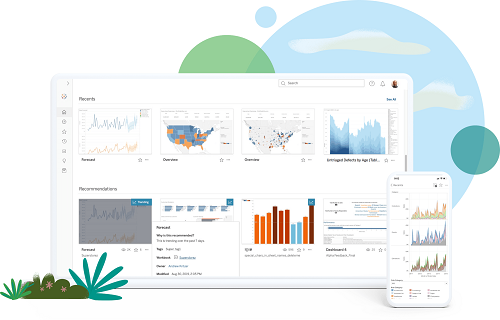The majority of business leaders today recognise and want to harness the power of data. But only about a third of the workforce feel empowered to do so in their day-to-day life. There! That’s the gap, that’s a wrap. Empower your workforce and job done. Blog done. But wait. Of course, it’s not as simple as that. Let me share a secret: the data gap is not just a single gap. It’s a whole bunch of gaps of varying shapes and sizes. Let’s have a look at some prominent examples to understand what businesses are dealing with – and how to start building bridges.
Gap 1: From expectation to reality
There is still a common misconception that with enough data you’ll be able to solve all your problems. This falls way short of the mark. In fact, 31% of executives in a recent global YouGov survey report they have too much data, while 54% cite the lack of understanding of data as a major barrier to evolving their business conversations.
The solution is not a simple one. Beyond shifting the general perception to a more realistic view, there are technological challenges to master, organisational hurdles to overcome, and a workforce to empower. To succeed you need: to collect what data you need and give your people the data they need - in a way that is useful to them.
“31% of executives admit they have too much data”
“54% cite the lack of understanding of data as a major barrier”
Gap 2: From silo to silo
Have you ever tried to get your contacts database from one email program to another? Then you already know that data simply does not equal data. It is collected, generated, and stored in almost as many ways and formats as there are systems and devices that collect, generate, and store it. But it's not just systems and devices: 53% of executives in the previously mentioned survey said COVID-19 revealed gaps in information sharing between teams.
The challenge is to bring data from all these systems and devices together – and to create a big picture that doesn’t lose detail at any given level. You'll also have to get all your teams on board so they work from the same source of truth. Only then can you generate insights that are not limited to the frame of reference of one device, system or department.
Gap 3: From data steward to business user
To build this bridge, you need data experts who know what data to collect, how to store it, how to access it and keep it safe. Ideally, they know everything there is to know about the data your organisation has available and the systems it is stored in. This does not necessarily make them best placed to make business decisions based on that data. For that, you need experts who know what the data is about. Whether it’s management looking to successfully steer strategy or a frontline worker trying to have the best possible customer interaction – data can truly drive value when used to make better decisions by those doing the actual work.
Yet 34% of the surveyed business leaders report a lack of trust in data as a barrier to success. And 48% say making data accessible to non-data-savvy people is important for decision making. Business users need to be able to interpret and - crucially - trust the data they are working with to have confident conversations and make confident decisions.
Gap 4: From data democratisation to governance and security
Trust has to work both ways. Organisations providing employees with access to confidential data need to ensure that data is being used responsibly. After all, much of that data is entrusted to an organisation by its customers. And providing employees access warrants a number of precautions, especially in a business environment.
In restricting access, however, organisations run the risk of missing out on valuable insights and keeping business critical information locked away in silos. After all, 47% of business executives say opening conversations up to people who are closest to the topic - like staff from the manufacturing floor or retail store - improves the quality of business discussions. There is definitely a tightrope to walk between reaping the benefits of democratised data and keeping your data secure.
No wonder then, that organisations struggle to find success in an ever more data-driven world. The sheer ubiquity of data makes bridging all these gaps a daunting task. And while it may be relatively easy to bridge one gap by itself, to end up with a single big bridge spanning the chasm between data and actionable insight requires careful planning.
Where are you on your data journey? Have you started building bridges already, or are you just dipping a toe? In part two of "Mind the (data) gap", we'll look at some examples from organisations that are already successful bridge builders. In the meantime, why not take a few minutes to assess your data gaps?
Tableau gives your whole team an analytics platform that makes it easy to dive deep into the data, find insights, and drive your business forward. Learn more about Tableau.






